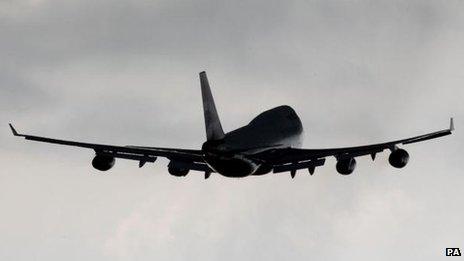Airports: What's the big fuss?
- Published
- comments

Perhaps the most striking conclusion of the Airports Commission chaired by Sir Howard Davies is that the economic cost of the capacity constraints at UK airports, and at Heathrow in particular, will be between 0.03% and 0.05% of GDP by 2030 and up to 0.09% of national income by 2050.
This is not huge.
A loss of income of this size looks like a rounding error in comparison with the peak-to-trough fall in national income of more than 7% caused by the 2008 banking crisis or the 20% gap between today's GDP and where it would have been if the pre-Crash growth trends had been sustained.
Or to put it another way, keeping the banking system solid and sound looks a rather more important priority than whether or not Heathrow gets a new runway or the London Mayor builds his vast new flying city on the Isle of Grain.
And yet airports and runways seem to get people's hackles and passions up in a way that risk weightings for bank lending and leverage ratios never do.
Which is not to say that the decision about where or whether to build new runways is trivial, but that it's not make or break for the British economy.
What is also very interesting in the report is the way it pours cold water on the notion that top rank economies must have a so-called hub - an airport flying almost everywhere and servicing gazillions of transit passengers - of unlimited capacity, which is what both Heathrow and Boris Johnson rather imply.
It paints a picture of a constrained Heathrow still performing extremely well. And it believes existing capacity can be used more efficiently through improved transport links between airports and better sharing of information by them.
So what will the Commission's final recommendation end up being?
Even though it is continuing to evaluate Johnson's grand design in the Thames Estuary, the £112bn expense looks so large compared with the putative costs of doing nothing at all - up to £20bn to airport users and providers over 60 years, and a maximum of £45bn to the wider economy over the same period - that lift-off seems almost inconceivable.
What of the choice between the two Heathrow options and a new runway at Gatwick?
Well if it became clear that low cost airlines such as Ryanair and Easyjet - which have been responsible for all the growth in flying over recent years - were to offer long-haul and transit services to popular destinations from Gatwick, that would allow considerable capacity to be liberated at Heathrow.
Or to put it another way, an expanded Gatwick might allow Heathrow to be a less constrained hub.
Whether the low-cost carriers rise to that challenge is uncertain - although whoever wins the election would be thrilled not to be given the verdict that only Heathrow has the X-factor (and, by the by, the Commission reminds us that its predecessor inquiries have a 100% record of being ignored by their sponsoring governments).